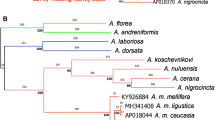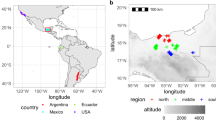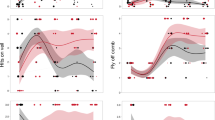Abstract
BECAUSE of a number of behavioural, ecological and physiological factors, African honeybees (Apis mellifera scutellata) are better adapted to tropical environments than European bees. African bees achieve higher rates of reproduction and colony growth partly by collecting more pollen relative to nectar1 and by allocating more nutrients to brood rearing2. African colonies generate more swarms3,4 which travel far greater distances5. These adaptive traits have been dramatically manifested in the neotropics: African bees have formed large expanding feral populations, whereas few European bees have survived outside apiaries6. The feral populations consist of African matrilines7–9 that have not hybridized extensively with European drones from apiaries10. Perhaps because of their European heritage, hybrids are poorly adapted to the tropics and thus do not survive. European matrilines, however, do not become part of the feral population, even after repeated backcrossing with feral African drones7–10. Conceivably, negative heterosis could further reduce hybrid survival, where European maternal factors are particularly detrimental7. We report here physiological findings consistent with these possibilities. Mass-specific metabolic capacities were higher in African bees than in European bees and were low and nonintermediate in hybrids. Thus, higher metabolic and flight capacities may contribute to African bees' competitive advantages in the tropics.
This is a preview of subscription content, access via your institution
Access options
Subscribe to this journal
Receive 51 print issues and online access
$199.00 per year
only $3.90 per issue
Buy this article
- Purchase on SpringerLink
- Instant access to full article PDF
Prices may be subject to local taxes which are calculated during checkout
Similar content being viewed by others
References
Danka, R. G., Hellmich, R. L. II, Rinderer, T. E. & Collins, A. M. Anim. Behav. 35, 1858–1863 (1987).
Winston, M. L., in The ‘African’ Honey Bee (eds Spivak, M., Fletcher, D. J. C. & Breed, M. D.) 201–212 (Westview, Boulder, 1991).
Winston, M. L., Dropkin, J. & Taylor, O. R. Oecologia 48, 407–413 (1981).
Otis, G. W. in Social Insects of the Tropics Vol. I (ed. Jaisson, P.) 209–219 (Université Paris-Nord, Paris, 1982).
Fletcher, D. J. A. Rev. Ent. 23, 151–171 (1978).
Michener, C. D. A. Rev. Entomol. 20, 399–416 (1975).
Hall, H. G. & Muralidharan, K. Nature 339, 211–213 (1989).
Smith, D. R., Taylor, O. R. & Brown, W. W. Nature 339, 213–215 (1989).
Hall, H. G. & Smith, D. R. Proc. natn. Acad. Sci. U.S.A. 88, 4548–4552 (1991).
Hall, H. G. Genetics 125, 611–621 (1990).
Winston, M. L., Taylor, O. R. & Otis, G. W. Bee World 64, 12–21 (1983).
Winston, M. L. & Katz, S. J. Can. J. Zool. 59, 1571–1575 (1981).
Heinrich, B. J. exp. Biol. 80, 217–229 (1981).
Southwick, E. E., Roubik, D. W. & Williams, J. M. Comp. Biochem. Physiol. A97, 1–8 (1990).
Casey, T. M. in Insect Flight (eds Goldsworthy, G. J. & Wheeler, C. H.) 257–272 (CRC Press, Boca Raton, FL, 1989).
Wolf, T., Schmid-Hempel, P., Ellington, C. P. & Stevenson, R. D. Funct. Ecol. 3, 417–424 (1989).
Collins, A. M. & Rinderer, T. E. in The ‘African’ Honey Bee (eds Spivak, M., Fletcher, D. J. C. & Breed, M. D.) 309–328 (Westview, Boulder, 1991).
Stort, A. C. & Gonçalves, L. S. in The ‘African’ Honey Bee (ed Spivak, M., Fletcher, D. J. C. & Breed, M. D.) 329–358 (Westview, Boulder, 1991).
Guzmán-Novoa, E. & Page, R. E. Ann. Ent. Soc. Am. (in the press).
Wilkinson, L. SYSTAT: the System for Statistics (SYSTAT Inc., Evanston, IL, 1990).
Rinderer, T. E., Stelzer, J. A., Oldroyd, B. P., Buco, S. M. & Rubink, W. L. Science 253, 309–311 (1991).
Taylor, O. R. Bull. Ent. Soc. Am. 31, 14–24 (1985).
Sheppard, W. S., Rinderer, T. E., Mazzoli, J. A., Stelzer, J. A. & Shimanuki, H. Nature 349, 782–784 (1991).
Lobo, J. A., Lama, M. A. & Mestriner, M. A. Evolution 43, 794–802 (1989).
Hall, H. G. Florida Ent 75, 51–59 (1992).
Hall, H. G. in The ‘African’ Honey Bee (eds Spivak, M., Fletcher. D. J. C. & Breed, M. D.) 45–76 (Westview, Boulder, 1991).
Harrison, J. F., Phillips, J. E. & Gleeson, T. T. Physiol. Zool. 64, 451–472 (1991).
Beenakkers, A. M. Th, Van Der Horst, D. J. & Van Marrewijk, W. J. A. Insect Biochem. 14, 243–260 (1984).
Casey, T., May, M. L. & Morgan, K. R. J. exp. Biol. 116, 271–289 (1985).
Coehlo, J. R. Environ. Ent. 20, 1627–1635 (1991).
Author information
Authors and Affiliations
Rights and permissions
About this article
Cite this article
Harrison, J., Hall, H. African-European honeybee hybrids have low nonintermediate metabolic capacities. Nature 363, 258–260 (1993). https://doi.org/10.1038/363258a0
Received:
Accepted:
Issue date:
DOI: https://doi.org/10.1038/363258a0
This article is cited by
-
Longevity, food consumption, and foraging performance of Apis cerana and Apis mellifera in mixed colonies
Apidologie (2019)
-
The frequency of African (Apis mellifera scutellata Lepeletier) matrilineal usurpation of managed European-derived honey bee (A. mellifera L.) colonies in the southeastern United States
Insectes Sociaux (2015)
-
Metabolism and upper thermal limits of Apis mellifera carnica and A. m. ligustica
Apidologie (2014)
-
Thermoregulation in the primitively eusocial paper wasp, Polistes dominulus
Insectes Sociaux (2010)
-
Racial admixture of Apis mellifera in Tasmania, Australia: similarities and differences with natural hybrid zones in Europe
Heredity (1995)



